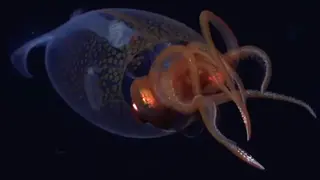For the first time in history, a colossal squid has been captured on video in its natural habitat, marking a groundbreaking moment in marine research. The footage, taken near the South Sandwich Islands in the South Atlantic, offers an unprecedented glimpse into a creature that has fascinated scientists for over a century. The juvenile squid, measuring 11.
8 inches in length, was spotted at a depth of 1,970 feet during a research expedition in March. The discovery was part of a 35-day mission led by a team of scientists, including Dr. Michelle Taylor from the University of Essex.

The goal was to uncover new marine species in one of the planet’s most remote and unexplored regions. The squid was filmed using a remotely operated vehicle aboard the Schmidt Ocean Institute’s research vessel, Falkor. Initially, the team wasn’t certain of the squid’s identity, but Taylor described it as “beautiful and unusual,” prompting them to document the encounter.
The footage was later reviewed and confirmed by squid expert Dr. Kat Bolstad, who remarked on the rarity of such an observation. “It’s exciting to see the first in situ footage of a juvenile colossal and humbling to think that they have no idea that humans exist,” she said.
Previous encounters with colossal squids were limited to remains found in the stomachs of predators like whales and seabirds. Get the Ynetnews app on your smartphone: Google Play : https://bit.ly/4eJ37pE | Apple App Store : https://bit.
ly/3ZL7iNv The colossal squid, which is believed to reach lengths of up to 23 feet and can weigh as much as 1,100 lbs., holds the title of the heaviest invertebrate on Earth. Despite its size and significance, much about its life cycle remains shrouded in mystery.
Juveniles begin life with a transparent appearance, which they lose as they mature. Another unique characteristic of the species is the presence of hooks along the center of their eight arms. Although dying adults have been caught by fishing operations in the past, live specimens at depth had never been observed—until now.
This sighting coincided with the 100-year anniversary of the initial discovery and naming of the species, making the event even more remarkable. However, estimating the global population of colossal squids remains an enormous challenge. According to the Natural History Museum, their elusive nature has kept them “straddling the line between legend and reality.
” Adding to the excitement, the Schmidt Ocean Institute team also made another historic discovery earlier this year. In January, they captured footage of a glacial glass squid for the very first time. With its semi-transparent body and orange-tinted upper half, the glass squid adds to the growing list of enigmatic creatures inhabiting the southern ocean.
Reflecting on the mission’s success, Schmidt Ocean Institute’s executive director, Dr. Jyotika Virmani, highlighted the rarity of these observations. “The first sighting of two different squids on back-to-back expeditions is remarkable and shows how little we have seen of the magnificent inhabitants of the southern ocean,” she said.
“These unforgettable moments continue to remind us that the ocean is brimming with mysteries yet to be solved.” >.
Environment

Rare sighting: Colossal squid filmed in ocean depths during research mission

Research team in the South Atlantic captures the first-ever footage of a juvenile colossal squid, revealing new insights into the life of the planet’s heaviest invertebrate, a species shrouded in mystery for a century














